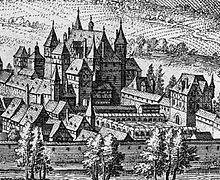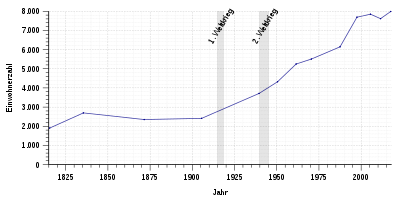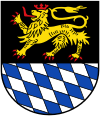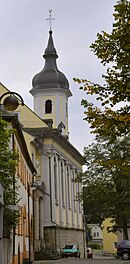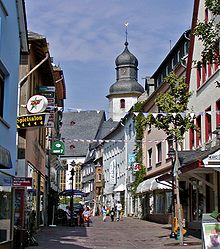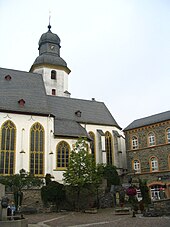Simmern / Hunsrück
| coat of arms | Germany map | |
|---|---|---|

|
Coordinates: 49 ° 59 ' N , 7 ° 31' E |
|
| Basic data | ||
| State : | Rhineland-Palatinate | |
| County : | Rhein-Hunsrück district | |
| Association municipality : | Simmern-Rheinböllen | |
| Height : | 400 m above sea level NHN | |
| Area : | 11.96 km 2 | |
| Residents: | 7899 (Dec. 31, 2019) | |
| Population density : | 660 inhabitants per km 2 | |
| Postal code : | 55469 | |
| Area code : | 06761 | |
| License plate : | SIM, GOA | |
| Community key : | 07 1 40 144 | |
| LOCODE : | DE SIM | |
| Association administration address: | Brühlstrasse 2 55469 Simmern / Hunsrück |
|
| Website : | ||
| City Mayor : | Andreas Nikolay ( CDU ) | |
| Location of the city of Simmern / Hunsrück in the Rhein-Hunsrück district | ||
Simmern / Hunsrück is the district town of the Rhein-Hunsrück district and one of the two administrative headquarters of the Simmern-Rheinböllen community . According to state planning, Simmern is designated as a medium-sized center.
geography
location
Simmern lies, touched by the 50th parallel, in the low mountain range of the Hunsrück in the so-called Simmerner Mulde . The old city center is located in the valley of the Simmerbach , the newer parts of the city spread out on the surrounding heights. The Külzbach flows into the Simmerbach on the western outskirts. East of the city there is a local recreation area with the artificially created Simmersee. The hills of the Soonwald begin south of the city with part of the Simmern city forest.
The area of the city is 1196 hectares. Simmern is of great tourist interest because of its high natural and leisure value, the central location to the Moselle , the Middle Rhine and the Nahe , which are each about 25 km away, allows day trips to other nearby destinations. Many deeply cut valleys connect the Hunsrück plateau with the river valleys and can be hiked.
Urban area
For the city of Simmern includes the residential places domain Eichenhof, House Bergschlößchen (former brewery), Hunsrück, House Seeberg Haus Vogelsang, Marienhof, Marthahof (Schafhof) Reginahof, Römerhof, shooting range, Sonnenhof, Waldhof and Rheinbacher courtyards.
climate
The annual precipitation is 690 mm. The precipitation is in the middle third of the values recorded in Germany. Lower values are registered at 38% of the measuring stations of the German Weather Service . The driest month is January, the most precipitation falls in August. In August there is 2.1 times more rainfall than in January. Precipitation varies greatly. Higher seasonal fluctuations are registered at only 25% of the measuring stations.
history
Surname
The name Simmern possibly comes from the Middle High German word Semida ( rushes ) ( d / t in the Hunsrück language > r and e > i = Siemera in connection with ( Old High German ) aha (water)). In the Hunsrück dialect, rushes are still called Sieme today.
The town has had the name “Hunsrück” since June 1, 1980 to distinguish it from other communities of the same name .
Middle Ages and early modern times
Simmern was first mentioned in a document in 1072, but the urban area was already settled in Roman times. Entries made before the 11th century cannot be assigned with certainty or describe the Simmerbach. Simmern was on the important military road Bingen - Trier . At first it belonged to the Nahegaugrafen, later it became the property of the Raugrafen . In 1311 Simmern is mentioned as a Luxembourg fiefdom , in 1323/1330 the fiefdom of the county of Luxembourg was transferred to the Archbishopric of Trier . Perhaps through the mediation of Archbishop Balduin , Simmern received city rights in 1330 from Emperor Ludwig the Bavarian . The town's weekly and annual markets soon attracted traders from all over the Hunsrück and ensured that trade and industry flourished. The right to fortification with a city wall, which was provided with a series of towers and gates, was connected with the city law. In the 14th century, Simmern came to the Count Palatine from the House of Wittelsbach . In 1377 a Trier feudal sovereignty over Simmern is attested for the last time, later this no longer appears.
The Palatine Wittelsbacher split in 1410 after the death of Ruprecht III. , who also held the German royal crown, into several lines, including the Pfalz-Simmern line , which took its residence in the city. The Dukes Stefan von Pfalz-Simmern-Zweibrücken , Friedrich I von Pfalz-Simmern , Johann I and above all Johann II are to be mentioned of the city and particularly promoted sculpture. Johann II was open to the ideas of the Reformation, but it was only his sons who introduced the Reformation , which led to tensions with the surrounding archbishoprics of Trier and Mainz. Johann II was followed by his eldest son and later Count Palatine and Elector Friedrich III. , called "the Pious", who switched to Calvinism in 1563 and played a leading role in imperial politics. In 1559 the Palatinate-Simmern line followed the extinct main Palatinate line with the electoral dignity in Heidelberg . The brothers Friedrich III, Georg and Reichard , ended the line of the dukes of Palatinate-Simmern, whose property fell back to the electorate under Friedrich IV after Reichard's death in 1598 .
Wars for the Palatinate
With his candidacy for the Bohemian royal throne as "Winter King", Friedrich IV's son Friedrich V contributed to the fact that the Thirty Years' War also affected his possessions in the Rhine Palatinate. These were now with justification of the younger branch Palatinate-Simmern by his brother Louis Philippe was divided again in 1611, but even this coincides with the death of his son Ludwig Heinrich 1673 back to the main line under Karl I. Ludwig back of the Peace of Westphalia , the Regained electoral status. During the Thirty Years War Simmern was conquered by Spanish troops under Spinola in 1620 . In 1631, the Swedes ousted the Spanish occupation. Thanks to its fortifications, the city was able to survive the chaos of war relatively undamaged. But the death of Karl I's son, Karl II, caused new turmoil, since with him the line of the Palatinate Wittelsbach family died out and France registered property rights. Liselotte von der Pfalz , sister of Charles II and, in the eyes of the French, entitled to inheritance, was married to Philip I of Orléans , the brother of Louis XIV ; But since the Wittelsbach line from Pfalz to Neuburg also made claims to the Simmern legacy, the Palatinate War of Succession broke out in 1688 , during which the French devastated large areas of the Palatinate.

In 1685 the Duchy of Simmern fell to the Pfalz-Neuburg line. This reintroduced the Catholic creed and in 1686 called the Boppard Carmel to look after the Catholics in the town and district of Simmern. With the help of the Schenk von Schmidtburg family , the Carmelites founded a branch in Simmern and, together with the Kreuznach Capuchin monks, took over pastoral care in the town . The city of Simmern itself had recently been literally inundated by numerous Huguenots who had escaped religious persecution in France. In 1688 French troops occupied Simmern in the course of the Palatine War of Succession . In the course of 1689, the destruction of the city fortifications began. The big city tower on the Römerberg was blown up. Finally, on September 17, 1689, French troops set the town and castle on fire. The castle, like the one in Heidelberg, became a ruin, only Stefanskirche, the Pulverturm (later the Schinderhannesturm ) and a handful of houses survived the disaster. After all, the Palatinate remained Wittelsbach as a result of the Peace of Rijswijk . In the 18th century, Simmern was only the seat of a Palatinate Oberamt, as the electors resided in Mannheim.
18th to 20th century
After the occupation of the Left Bank of the Rhine (1794) by French revolutionary troops , the place belonged to the Rhine-Moselle department from 1798 to 1814 . Simmern became the capital of an arrondissement and a canton . During the regular patrols of the newly founded National Gendarmerie , Johannes Bückler , later known as a robber , called "Schinderhannes", was caught, who was still active as a petty cattle thief in Hunsrück and Northern Palatinate at that time. In 1799 he spent half a year in today's Schinderhannes Tower in Simmern, from where he managed to escape. In 1804, Emperor Napoleon I stayed in the city, which in the meantime had also received city administration under French law.
Due to the agreements made at the Congress of Vienna (1815), the region was assigned to the Kingdom of Prussia . Under the Prussian administration, the canton of Simmern was incorporated into the newly formed district of Simmern in the Koblenz administrative district .
The situation in the city, which was somewhat remote from the centers of industrialization, was not easy in the 19th century, especially since potato rot and poor harvests occurred in 1845, which led many residents to emigrate to America.
During the First World War , Simmern was an important base on the stage of the Western Front. In the interwar period, the city, which was again occupied by the French until 1930, suffered from the economic situation of that time. In World War II , there was devastation again. In March 1945 Simmern was occupied by US troops, then added to the French occupation zone with the Palatinate and has belonged to the state of Rhineland-Palatinate since 1946.
In 1920 three fragments of a meteorite fell in the vicinity of Simmern , weighing a total of 1222 grams. The meteorite was classified as a type H5 chondrite .
On April 15, 1999, an area swap was carried out with the community of Muttigart , which resulted in several residents changing their affiliation to the community.
Demographic statistics
The development of the population of Simmern, the values from 1871 to 1987 are based on censuses:
Denomination statistics
According to the 2011 census , the majority of the population was 43.9% Protestant , 31.4% Roman Catholic and 24.6% were non-denominational , belonged to another religious community or did not provide any information. Currently (as of May 31, 2020) 37.7% of the population are Protestant, 26.5% Roman Catholic and 35.8% are non-denominational or belong to another religious community. The number of Protestants and Catholics has therefore decreased in the observed period.
politics
City council
The city council in Simmern / Hunsrück consists of 24 council members, who were elected in a personalized proportional representation in the local elections on May 26, 2019 , and the honorary city mayor as chairman.
The distribution of seats in the city council:
| choice | SPD | CDU | FDP | Green | aSL | total |
|---|---|---|---|---|---|---|
| 2019 | 6th | 9 | 2 | 3 | 4th | 24 seats |
| 2014 | 6th | 11 | 1 | 2 | 4th | 24 seats |
| 2009 | 6th | 10 | 2 | 2 | 4th | 24 seats |
| 2004 | 6th | 12 | 1 | 1 | 4th | 24 seats |
- aSL = anStadt Liste e. V.
mayor
- 1949–1966: Fritz Vollbracht
- 1966–1975: Kurt Schöllhammer
- 1975-1977: Albert Lax
- 1977–1979: Karl Windhäuser
- 1979–1987: Wolfram Berg
- ...
- 1999–2009: Manfred Faust
- 2009– : Andreas Nikolay
In the local elections on May 26, 2019, Andreas Nikolay was confirmed in his office with 67.90% of the vote.
coat of arms
| Blazon : “Divided; above in black a striding red crowned and armored golden (yellow) lion; at the bottom diagonally roughened ( awakened ) in silver (white) and blue. " | |
| Reasons for the coat of arms: The coat of arms refers to the Palatinate lion and the Wittelsbach rulers who ruled from 1358 onwards and who had the (white-blue) Bavarian alarm clock in their coat of arms. The coat of arms was approved in 1901 and refers to the oldest seal, dated before 1400. |
Twin cities
- Migennes in the Burgundy region , France, since 1969
- Igrejinha in the state of Rio Grande do Sul , Brazil, since 2013
- Mänttä-Vilppula in Finland, since May 7, 2019
Culture and sights
- Stephanskirche: Late Gothic Protestant church, built under Duke Johann I from 1486 to 1510 as an extension of an older complex, the remains of which can still be found under the tower. On the south aisle there is the St. Anna Chapel with the grave monuments of the Simmern dukes . Further epitaphs can be found in the choir of the church, they are among the most famous testimonies of the Renaissance culture between Mainz and Trier. The sculptural work is assigned to the workshop of the Koblenz carver Jakob Kern (or Kerre ), a student of Hans Backoffen (around 1520), furthermore Johann von Trarbach (1530–1586) and a hitherto unknown master from Simmern. Under the bell tower is another crypt with the coffins of the last Simmern prince couple (Duke Ludwig Heinrich , † 1674 and Maria von Oranien , † 1688). The historic organ from 1776 comes from the workshop of the Sulzbach organ builder family Stumm . Behind the St. Stephen's Church was the Holy Cross Chapel, which bordered the north corner of the old city fortifications. The adjoining churchyard was closed in 1564, given to the Catholics and not used since 1813.
- Catholic parish church St. Josef: The baroque Roman Catholic church was built in the years 1749–1752 with the permission of Elector Karl Theodor von der Pfalz . The plans for this were made by the building and works foreman Johann Jakob Rischer from the Electoral Palatinate . A semicircular choir adjoins the rectangular nave hall , at the top of which rises the bell tower crowned with a hood . A two-storey vestibule with a portal and outside staircase connects the church with the former Carmelite monastery , which was built in 1703/04 and is now used as a parish office. Inside, the ceiling frescoes (1752–1756) by the Mannheim court painter Francesco Bernardini , which depict the adoration of the child , deserve a mention . The original high altar, erected on November 7, 1753, is attributed to the Mannheim sculptor Paul Egell (1691–1752; in Mannheim since 1721). The organ was delivered on October 9th, 1753 by the organ builder family Stumm from Rhaunen. The last restoration of the church took place in 2002.
- Cultural center in Simmern Castle : The new castle was built in 1708 as an administrative building for the senior bailiff. In the same place stood the medieval castle, which was expanded as a residence in the second half of the 15th century and destroyed together with the city in 1689. Today it houses:
- Hunsrück Museum
- Friedrich Karl Ströher art collection (Hunsrück painter)
- Wedding room of the registry office
- Library in the castle
- Tourist information
- Schinderhannesturm: The robber Johannes Bückler , known as Schinderhannes , was trapped in the former powder magazine and prison room on the outer former city wall . Schinderhannes was imprisoned there at the end of February 1799, but was able to flee on the night of August 19 to August 20, 1799. On November 29, 1798, his friend, Johann Peter Petri , called Schwarzer Peter , fled from the tower, which had previously been considered safe from escape. As one of the few buildings in Simmern, the tower survived the great fire of 1689. The steep baroque conical roof and the western flight of stairs come from 1750. Today, the visitor can find the exhibition Reality and Myth of Schinderhannes in the multi-storey restored tower with numerous original exhibits, some of them from the personal belongings of the robber captain. On the square in front of the tower, a sculpture commemorates a pig theft by Schinderhannes and a friend in 1797.
- Another remnant of the tower is located north of St. Stephen's Church. Remnants of the medieval city wall can still be seen on Koblenzer Straße and at the end of Mühlengasse, where a part that was previously covered by residential buildings was exposed and renovated.
- Schwarzer Adler restaurant: One of the few houses that had been spared the destruction of the city in 1689. In addition to the Stephanskirche and the Schinderhannesturm, it is one of the oldest buildings in the city today. After a fire, however, only the lower part with the cellar vault is historic, above it is a new building.
- Other sights in the Simmern / Hunsrück community:
- Museum of cultural history in Neuerkirch
- Ravengiersburg Monastery
- Nunkirche (Sargenroth)
- Wildburg (Sargenroth)
- Bismarck Tower (Sargenroth)
- Historic water mill from 1887 in Niederkumbd
- Former Schönenberg cemetery (south of Riegenroth ): sandstone cross, marked 1777
Economy and Infrastructure
traffic
The four-lane federal highway 50 , with connection to the A 61 near Rheinböllen, runs south of the city. The Simmern station is currently only used as a bus station because the line of the Hunsrück Railway Boppard - Simmern has been closed and dismantled and the line of the Hunsrückquerbahn Bingen am Rhein - Hermeskeil is currently not used.
Companies
The city's larger employers include: Boge Elastmetall GmbH (approx. 500 employees), CompAir compressed air technology (approx. 500 employees), Pfefferkorn (champagne stopper manufacturer), Deutsche Fertighaus Holding (prefabricated house construction), SchwörerHaus KG, a production facility of solid fort houses, cellars, ceilings and precast concrete parts, Zischka textile care (large laundry), BS security service (money and valuables transport, logistics), the Hunsrück Clinic and DHL with a logistics center. In addition, the headquarters of the Thomas Group is in Simmern. There are also several hypermarkets and a large number of smaller service providers. In recent years, Simmern has developed into a regional center for the automotive trade.
Public facilities
The city is the seat of the district court Simmern / Hunsrück . In addition to the city and district administration, a number of other offices can be found, including finance, forestry, health and land registry offices, police, branch of the Koblenz Chamber of Commerce and Industry, and district craftsmen. Simmern is also the location of a technology and start-up center. The Hunsrück Museum documents the city's history and shows everyday objects and paintings from the city and region. There is also a cinema (“Pro-Winz-Kino”). In addition to the VfR 1921 Simmern, the city has a wide range of other clubs. The advertising community Simmern attracted e. V., for example, is the association of businesses in the city. They have set themselves the goal of strengthening the retail location and making the city even more attractive for citizens, customers and visitors.

education
At educational institutions there are two elementary schools, the Kurt-Schöllhammer-Grundschule and the Rottmannschule, as well as a Realschule plus , the state, mathematical and scientific Herzog-Johann-Gymnasium , the vocational school with a business high school, several technical and technical colleges and the Hunsrück School for the learning disabled. The adult education center is committed to adult education.
leisure
In Simmern there is a recreational indoor and natural outdoor pool , the indoor children's adventure world "jungle village", a youth café, a skate park and a cinema.
The Schinderhannes cycle path begins on the western outskirts of the city . From there it leads through the Külztal via Kastellaun to Emmelshausen . The Schinderhannes-Soonwald cycle path runs south and connects Simmern with the Soonwald .
In 2007 and 2008 the city held the Schinderhannes Festival for the first time . The play Der Ausbruch was premiered . It traced the adventurous escape of the robber captain from the city's former powder tower in August 1799. The powder tower was actually considered escape-proof. Today the tower is therefore called Schinderhannesturm. In 2010 there was the third Schinderhannes Festival, where the musical Julchen was premiered.
Sports
In Simmern, the VfR Simmern and the BGV Simmern are the sports clubs. VfR Simmern is known in football as SG Soonwald / Simmern (a game community with clubs in the area), table tennis (regional league) and handball as HSG Kastellaun / Simmern (a game community with TV Kastellaun 09). VfR Simmern also offers basketball, swimming, badminton and other sports. The Simmern tennis club plays in the TC Sportpark Simmern. Judo and Tai Chi are practiced in the Nippon Simmern judo club, which was created as a department in the VfR in 1960 and became independent in 1976.
Personalities
Born in Simmern
- Friedrich III. (1515–1576), Elector Palatinate
- Peter Joseph Rottmann (1799–1881), Hunsrück dialect poet
- Johann Adolf Lasinsky (1808–1871), painter and draftsman
- Lorenz Goetz (1810–1894), theologian, politician and member of the Frankfurt National Assembly
- Otto von Vacano (1827–1897), lawyer and President of the Colmar Higher Regional Court
- Otto von Westhoven (1834–1916), civil servant and member of parliament
- Eugen Eppstein (1878–1943 in Majdanek concentration camp), politician and member of the Reichstag
- Hans Becker (1888–1964), school inspectorate and politician (SPD)
- Richard Wolf (1894–1972), staff officer
- Bernhard Hermkes (1903–1995), architect and urban planner
- Rudolf Zischka (* 1928), recipient of the Federal Cross of Merit
- Hansgerd Schulte (1932–2019), President of the DAAD and professor of German studies in Paris
- Rolf Zerfaß (* 1934), Roman Catholic theologian
- Franz Dick (* 1943), psychologist
- Bernd Erbel (* 1947), diplomat
- Michael Linden (* 1948), neurologist and psychotherapist
- Christoph Spering (* 1959), conductor
- Elke Christina Roeder (* 1966), politician
- Andreas Spering (* 1966), conductor
- Gerlinde Countess von Westphalen (* 1966), gallery owner, publicist and curator
- Dan Zerfaß (* 1968), church musician
- Uwe Kirschstein (* 1977), politician (SPD)
- Carsten Braun (* 1978), composer
- Alexander Zerfaß (* 1978), Catholic theologian, professor of liturgical science
- Meike Anlauff (* 1979), rock and pop singer
- Carina Konrad (* 1982), qualified agricultural engineer and politician (FDP), Member of the Bundestag
- Benjamin Sohns (* 1982), electro musician
- Christopher Lauer (* 1984), member of the Berlin House of Representatives
- Kimberley Unser (* 1985), cook
Associated with simmers
- Johannes Bückler (1779–1803), robber , known as Schinderhannes , imprisoned in the Simmern city prison for almost half a year in 1799
- Johann Peter Petri (1752–1812), robber , called Schwarzer Peter or Der alten Schwarzpeter , companion of Johannes Bückler
- Pastor Julius Reuss (1814–1883), 1849 co-founder of Schmiedel
- Richard Oertel (1860–1932), Protestant theologian and politician
- Jakob Maria Josef Hart (1886–1970), priest, dean and honorary canon, headed the catholic church from 1928 to 1969. Parish of Simmern
- Rudolf Rumetsch (1921–1998), from 1959 to 1968 the last district administrator in the Simmern district
- Wolfgang Rumpf (1936–2006), forester and politician ( FDP ), headed the Simmern Forestry Office from 1971 to 1981
- Edgar Reitz (* 1932), film director , shot parts of the film Die Reise nach Wien as well as some scenes for Heimat - A German Chronicle and Heimat 3 - Chronicle of a Turning Point in Simmern . Edgar Reitz has been an honorary citizen of the city since 2002.
- Gudrun Landgrebe (* 1950), actress
- Günter Felke (1929–2005), entrepreneur and promoter of culture, awarded the badge of honor in 1987, holder of the badge of honor from 1994 and honorary citizen of the city of Simmern from 2000
- Andreas Armin d'Orfey (* 1961), internationally active artist and author.
- Dorothee Oberlinger (* 1969), musician, grew up in Simmern, since 2016 honorary citizen of the city.
- Felix Antoine Blume alias Kollegah (* 1984), rapper / musician, grew up in Simmern
- Ghada Shouaa (* 1972), track and field athlete and heptathlete , lives in Simmern
literature
- Wilhelm Fabricius : The Palatinate Oberamt Simmern . In: West German Journal for History and Art 28 (1909), pp. 70-131 ( digitized in the Internet Archive)
- Karl Faller: The St. Stephen's Church in Simmern, Hunsrück. (= Great Architectural Monuments . Issue 293). Munich / Berlin 1975.
- Ernst Siegel: The history of old houses, municipal facilities and facilities in Simmern. Simmern 1962.
- Karl Wagner: Simmern. History of the rulers and the city. Simmern 1930.
- Willi Wagner, Gustav Schellack: 650 years of the city of Simmern in the Hunsrück. Simmern 1980.
swell
- Diarium residentiae Carmelitarum in the Hunsrück Museum Simmern.
Web links
- The Oberstraße in Simmern in the SWR television program Hierzuland
- Literature about Simmern / Hunsrück in the Rhineland-Palatinate state bibliography
Individual evidence
- ↑ State Statistical Office of Rhineland-Palatinate - population status 2019, districts, communities, association communities ( help on this ).
- ↑ a b State Statistical Office Rhineland-Palatinate - regional data
- ↑ State Statistical Office Rhineland-Palatinate (ed.): Official directory of the municipalities and parts of the municipality. Status: January 2019 [ Version 2020 is available. ] . S. 62 (PDF; 3 MB).
- ↑ L. Armbrust: Hunsrück place names in the districts of Simmern and Zell. in "Rheinische Geschichtsblätter", 3rd year, no. 4, p. 101 Hansteins Verlag, Bonn 1897, dilibri.de
- ^ Walter Diemer: Hunsrück Dictionary. P. 232 (without reference to Simmern)
- ↑ Official municipality directory (= State Statistical Office of Rhineland-Palatinate [Hrsg.]: Statistical volumes . Volume 407 ). Bad Ems February 2016, p. 188 (PDF; 2.8 MB).
- ↑ Simmering. Meteoritical Bulletin, accessed June 7, 2020 .
- ↑ Simmering meteorite. mindat.org, accessed June 7, 2020 .
- ↑ Official municipality directory (= State Statistical Office of Rhineland-Palatinate [Hrsg.]: Statistical volumes . Volume 407 ). Bad Ems February 2016, p. 172 (PDF; 2.8 MB; see also p. 184, footnotes 44, 45, 65 and 66).
- ^ City of Simmern Religion , 2011 census
- ↑ City of Simmern municipal statistics , accessed on June 19, 2020
- ^ The Regional Returning Officer RLP: City Council Election 2019 City of Simmern. Retrieved October 5, 2019 .
- ^ The Regional Returning Officer Rhineland-Palatinate: Municipal elections 2014, city and municipal council elections
- ↑ The Regional Returning Officer RLP: direct elections 2019. Retrieved on October 5, 2019 (see Simmern-Rheinböllen, Verbandsgemeinde, 42nd line of results).
- ↑ Klemens Stadler: German coat of arms. Volume 2. Bremen 1966, p. 58.
- ↑ Simmerner Original "Greta"
- ^ Trarbach exhibition Hunsrück Museum ( Memento from May 22, 2014 in the Internet Archive )
- ↑ VfR 1921 Simmern e. V.
- ^ Judo Club NIPPON Simmern eV: Our association
- ↑ rhein-zeitung.de



